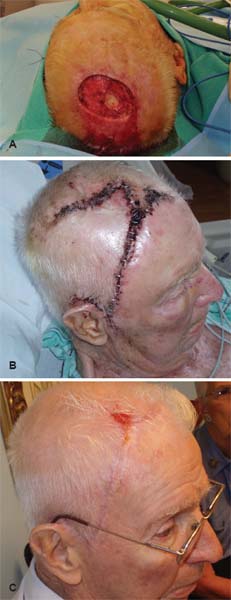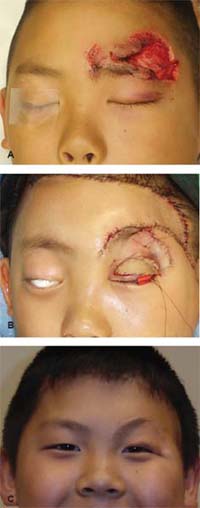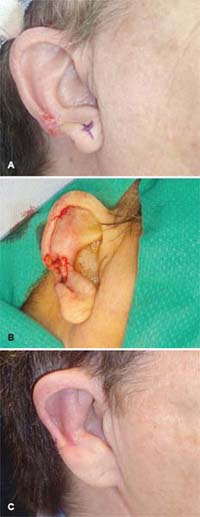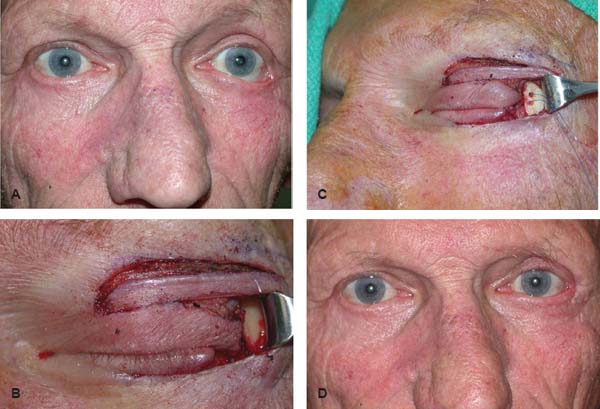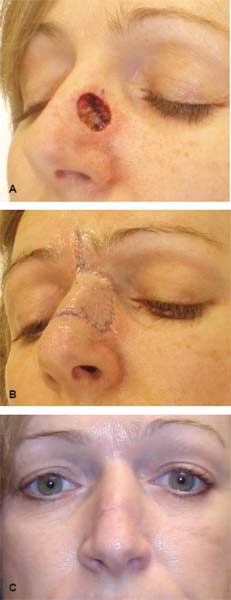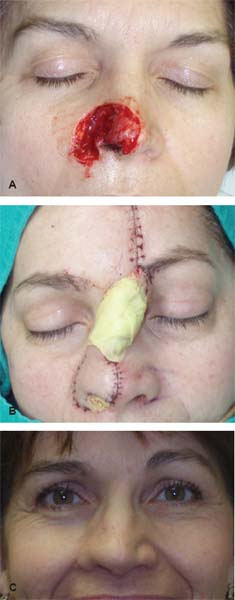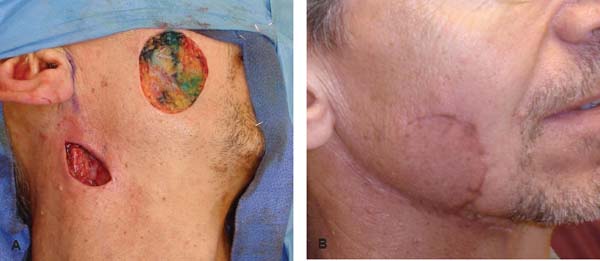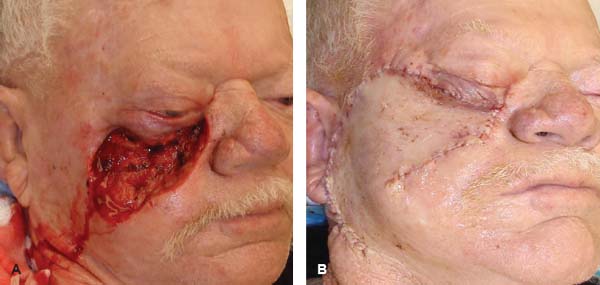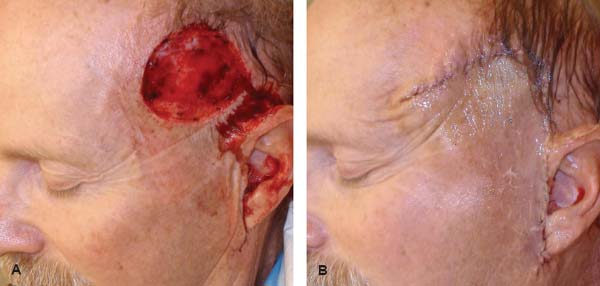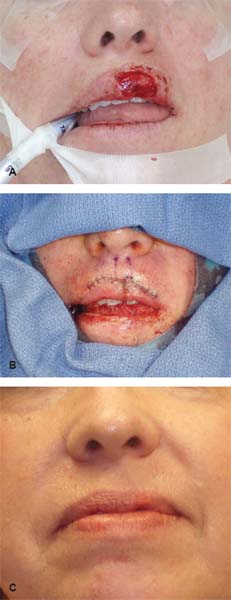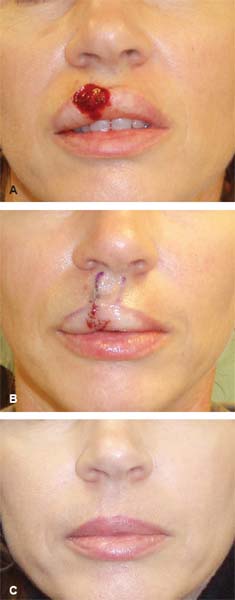29 Core Messages • Oncologic surgery is a prominent modality in the treatment of head and neck cancers. • The majority of the resultant defects will require some type of surgical reconstruction. • Thus, the reconstructive surgeon becomes a principal figure in safeguarding patients’ posttreatment function, cosmesis, and quality of life. • It is paramount that the reconstructive surgeon is well skilled in various reconstructive methods and chooses carefully an appropriate reconstructive technique. • This chapter describes a full gamut of reconstructive techniques, including healing by secondary intention, grafting, local and regional flaps, and microvascular tissue transfer. Excluding laryngeal malignancies, the survival rate for head and neck cancers (HNCs) has been steadily improving since 1975.1 While enjoying better survival rates, the focus is increasingly being placed on functional aspects and quality of life.2–4 According to the National Comprehensive Cancer Network guidelines, the surgical extirpation is either a preferred modality or an accepted alternative in the treatment algorithm for all stages of the majority of HNCs.5 Proper surgical reconstruction is a paramount aspect of rehabilitation of the patient with HNC and ideally should be completed or planned for at the time of the initial oncologic surgery. Furthermore, advanced reconstructive surgery becomes even more significant in either the setting of salvage surgery or the correction of the sequelae of the primary treatment modalities. The reconstructive surgeon is frequently challenged to restore not just a surface area of the defect but a complex three-dimensional (3D) anatomy to preserve numerous affected physiologic functions. The integrity of an aerodigestive tract is frequently breached during tumor extirpation and requires a repair to prevent a salivary and microbial cross-contamination to deep tissues of the neck and/or the central nervous system. Moreover, in ideal circumstances, the removed tissues must be replaced with similar type of tissues to maintain mastication, deglutition, airway, articulation, oral competence, and other important bodily functions. With most of the human senses concentrated around the head and neck region, hearing, vision, smell, and taste can be unnecessarily affected by a lack of or inadequate reconstruction. In addition, cosmesis must not be overlooked in these patients, as prominent facial features are often affected by head and neck tumors and their treatment. Functional deficits and cosmetic deformities may negatively affect patients’ personality and lifestyle. Consequently, patients with HNCs have a disproportionally high rate of depression and one of the highest rates of suicide as compared with patients with other malignancies.6,7 Several defects, such as small defects of oral tongue or small skin defects, can be closed primarily with excellent long-term cosmetic and functional outcome. Pearl • One must be careful in evaluating patients with anterior oral cavity defects. Seemingly small defects may result in a significant decrease in tongue volume or tethering of the tongue to the mandible, particularly when the floor of the mouth is involved. Primary closure in these situations is undesirable because of a high potential for future functional dysfunction. The decrease in tongue volume has been shown to affect both swallowing and articulation.8 Healing by secondary intention may also be possible and even advisable in some specific situations. It can be used in the setting of previous irradiation, although not as effectively as it is in nonirradiated tissues. Often, secondary healing is suitable as the initial treatment of fistulas. Nonetheless, it should be used only in the areas where contracture is not going to result in disfigurement or functional compromise. More importantly, an exposure of major organs or vessels may preclude the use of this delayed type of therapy altogether. Healing by secondary intention can be further facilitated by providing continuously moist environment.9 Several commercially available products provide the technology that can wick away an excess of exudate and provide the necessary moist environment as well as antimicrobial properties.10 Furthermore, the use of hydrocolloid, film, foam, and gel dressings has been shown to be more bacteriostatic and effective than a traditional wet-to-dry dressing.11 Negative pressure wound therapy, otherwise known as vacuum-assisted closure, has revolutionized how we manage wounds left to heal by secondary or tertiary intention. Since its introduction in 1997 by Argenta and Morykwas, the use of the negative pressure therapy has been tested in a variety of head and neck defects.12 It has been shown to be safe and efficacious. Various foams and dressings can be used in conjunction with a negative pressure device to control exudate evacuation and new granulation tissue formation. It has been used to aid the closure of difficult head and neck wounds either as a primary modality or as a preparation step for future grafting.13–15 If used appropriately, the negative pressure therapy has been shown to be a useful adjunct in the closure of orocutaneous and pharyngocutaneous fistulas.15,16 When surrounding tissues are not sufficient to support primary closure, healing by secondary intention, or nonvascularized grafts fails, a tissue transfer becomes necessary. Commonly, both medical professionals and patients use the term flap to describe various types of tissue transfers. This term is derived from a Middle English or Dutch word flappe, which originally meant “a partially attached broad flat piece or shingle.” Medical terminology redefined it as “a piece of tissue partly severed from its place of origin for use in surgical grafting.”17 Over the last four decades, with the advent of free tissue transfer, this term has become outdated as, unlike other flaps, free flaps are completely detached from its place of origin before transfer. Nonetheless, the definition of the word flap still holds water when applied to local and regional transfers. Furthermore, it is one of the most recognized and widely used terms in reconstructive surgery. Successful reconstruction of posttumor ablative defects of the head and neck region requires thoughtful consideration of many variables. Consideration must first be given to the overall health status of the patient and associated comorbidities. Factors such as metastatic disease, significant systemic disease, or extreme advanced age may influence the choice of reconstruction with possible avoidance of heroic measures or lengthy operations. Other patient factors such as diabetes, smoking, peripheral vascular disease, and radiation must be assessed as they will affect the healing process of the chosen reconstructive maneuver. Once a patient is deemed a candidate for reconstruction, attention is directed toward the thought process of choosing an individualized treatment plan. The basic concepts of restoration of form and function and avoiding donor site deformity must be kept in mind. A thorough and logical approach involves following certain steps to obtain optimal results: (1) accurate defect analysis and definition of specific tissue requirements, (2) understanding the detailed anatomy of the local and distant tissues as they may relate to the reconstruction, and (3) reviewing all surgical options and choosing the intervention that satisfies the tissue requirements with good cosmesis, provides the least morbidity, and allows for a stable and long-lasting result. For the reconstructive surgeon, steps 1 and 2 above are easily followed. Step 3, choosing the right option, comes from advanced training, experience, thoughtfulness, and knowledge of current and previous literature as it relates to the specific reconstruction. A thorough understanding of the reconstructive options is paramount in achieving a successful outcome. This option of reconstruction obviously requires little thought process in its planning and minimal to no intervention by the surgeon. It does require patience by the physician and patient and appropriate follow-up to assure adequate healing. Proper wound care and reassurance are also important aspects of the postoperative course. Fortunately, the excellent vascularity of the head and neck region allows open wounds to heal secondarily in an acceptable time period. Areas that are good candidates for secondary intention healing include small defects of the nasal tip and also medial canthal region. Minor defects in these areas may actually heal with improved cosmesis as compared with attempts at primary closure, which may actually cause more deformity. The upper forehead is another area that may obtain an improved aesthetic result if allowed to granulate as opposed to attempts at closure of the defect. The paramedian forehead flap donor site is an excellent example of this, where aggressive attempts at closure may result in distortion of the hairline or eyebrows. Defects of 2 to 3 cm or larger oftentimes heal remarkably well. It must be kept in mind, though as a prerequisite for secondary intention healing to occur, a well-vascularized wound bed must be present. In cases of exposed bone or cartilage, another reconstructive option should be used. Also, wounds that have previously been irradiated will also heal in a much delayed fashion. Other choices should also be considered in this situation. Another simple option low on the reconstructive ladder is primary closure. Wounds that can be closed directly without undue tension and that do not distort adjacent structures are best managed by this approach. A meticulous suturing technique that incorporates atraumatic tissue handling, tension-free skin closure, and eversion of skin edges allows for the best cosmetic result. Delicate handling of tissues is paramount to avoid unnecessary trauma to tissues and allow appropriate healing. Tissue should be grasped gently with forceps and skin hooks used, when applicable, to avoid crushing delicate skin. Sutures should also be placed properly to allow gentle eversion of wound edges to avoid depressed scars. Incision placement can sometimes be challenging for the beginning surgeon. Ideally, scars should be placed in the lines of minimal tension. This usually allows for the most inconspicuous scar. Other areas that lend to a well-camouflaged scar are incisions placed along the hairline, or along borders of facial subunits, for example, within the nasolabial crease. Before committing to an incision, one must look closely at the surrounding structures to assure that they will not be significantly distorted when the incision is closed. Skin grafts are classified as split-thickness skin graft (STSG) or full-thickness skin graft (FTSG) based on their composition of either epidermis and some portion of dermis or epidermis and entire dermis, respectively. STSG can be classified as very “thin” (approximately 6/1000 in.) to “thick” (more than 20/1000 in.) grafts. Both STSG and FTSG have advantages and disadvantages in terms of their donor and recipient site properties. STSGs have the advantage of ease of harvest and no need to close the donor site. Disadvantages of STSG include the need for specialized equipment, that is, dermatome, and the need for wound care for the donor defect. Other negative aspects include possible prolonged pain for the patient and unsightly scarring. FTSGs have the advantage of improved color and texture match. They can also be harvested from inconspicuous areas such retro- or preauricular skin creases. Disadvantages of FTSGs include the need for the closure of the donor site and possibly slightly less predictable “take.” Defects on the face are often reasonable candidates for FTSG. Areas that are particularly well suited for this are nasal defects and temporal defects. In general, local flaps provide a better option for nasal reconstruction, but in certain circumstances an FTSG is a viable option. An example would be a defect with a well-vascularized wound bed in which multiple previous scars on the nose preclude many typical local flap options. FTSG might also be considered in large defects in the temporal region in which no small local flaps are possible because of the likelihood of distorting the brow or hairline. Again, typically not a first-line option, an FTSG should always be kept in mind as a fairly simple option that provides an acceptable result. Large defects on the scalp or neck are often amenable to STSG as long as there is a well-vascularized wound bed, that is, no exposed bone, and so forth. Removal of the outer cortex of calvarium and skin grafting onto the diploic cancellous bone can circumvent this situation in select cases. The process of tissue expansion was introduced in the early 1900s and further refined and popularized in the 1950s.18 Its main benefit is that it provides an adjacent tissue of similar color and texture to the recipient area. It can also transfer hair-bearing and sensate tissue, if needed, for the reconstruction. Although not typically used in the acute setting for reconstruction of HNC defects, it is quite useful in the management of late post-tumor ablative defects or other nonmalignant settings such as congenital nevi and posttraumatic defects. It should also be noted that the previous radiation somewhat precludes the use of expansion. The expansion process is performed as a staged procedure. The first stage involves choosing an appropriately sized expander and inserting it into an area adjacent to the defect. There are multiple shapes and sizes of expanders available and the choice depends on the size of the defect, surrounding tissues, and the surgeon’s preference. In general, the amount of tissue gained is roughly equal to half of the width of the expander.19 After insertion, the incision is allowed to heal for 2 to 4 weeks before expansion is started. The patient visits the office on a weekly or biweekly basis for expansion. In the head and neck region, smaller volumes (25 to 50 cm3) are typically injected during each visit. Larger volumes may be injected depending on the site and patient tolerance. The expansion process is typically completed in 2 to 3 months. The second stage involves removal of the expander and rotation of the newly expanded tissue into the defect. In cases of large defects, multiple expanders or multiple expansion procedures may be required. Unfortunately, tissue expansion has a relatively high complication rate ranging from 25 to nearly 50%.20,21 The most common complication associated with the expansion process is infection. Other complications include hematoma, seroma, skin breakdown, expander exposure, and expander leakage or deflation. Fortunately, in certain circumstances, some of these complications can still allow for enough tissue expansion to complete the reconstruction. It is best to minimize these possible complications, though with meticulous planning and technique. Local flap reconstruction is quite commonly the best option to repair defects that cannot be closed primarily. They provide tissue of similar color, thickness, and texture. Reconstruction of defects of the head and neck with local flaps is oftentimes the most challenging and thought-provoking process for the reconstructive surgeon. Multiple considerations must be kept in mind. First of all, a thorough defect analysis should be performed noting 3D size of the defect. Structural analysis of the defect should also be performed, including the assessment of tissue requirements, that is, skin, cartilage, mucosa, and so on. It should also be noted which subunits of the face are involved and their proximity to anatomic landmarks, which is, eyebrow margin, eyelid margin, lip margin, and so on. One should visualize the placement of tissues into the area in such a way that it minimizes distortion and potential complication. Once a grasp has been obtained on specific details of the wound/recipient bed, one should begin to review different options for local flap reconstruction. This, of course, first requires knowledge of the multiple different local flaps available to the reconstructive surgeon. There are many ways to classify the various types of local flaps. Flaps may be classified by their composition (e.g., cutaneous, chondrocutaneous, myocutaneous, fascio-cutaneous), their blood supply (random or axial pattern), or direction of their movement (e.g., advancement, rotation). “Random flaps” as the name implies are not vascularized by a named blood vessel. These flaps maintain their blood supply via the subdermal plexus entering the flap from its base. In the face, length-to-width ratios of up to 5:1 may be possible because of the excellent vascularity but clinical judgment should be exercised in design.22 In certain situations, it may be possible to improve the vascularity of a random flap by performing a “delay” phenomenon.23 This involves incising the flap margins sometimes with elevation and placing back into the donor bed that allows for opening of “choke” vessels and perhaps vasculogenesis. One to three weeks later, the flap is elevated and transferred to the recipient site. A delay might also be considered intraoperatively if a flap demonstrates signs of vascular compromise after elevation. In contrast to random flaps, “axial pattern flaps” obtain their blood supply via a discrete blood vessel. They are generally more reliable than random flaps and should be considered for specific larger defects, for example, paramedian forehead flap. Local flaps are also classified based on the direction of their movement. An “advancement flap” is one in which the flap is advanced in a linear fashion. The simplest form of such a transfer is undermining and direct advancement of tissue into a defect. Usually, incisions are made to create a discrete flap, which is then transferred to the recipient area in an advancing fashion. Sometimes, the bipedicled flap can be created by leaving two separate bases to the flap. This provides additional blood supply to the flap but obviously limits its movement. Bipedicled flaps are potentially useful for select eyelid and intraoral defects. Another type of advancement flap that is quite useful is the V-Y advancement flap. This flap is created by making a V incision and releasing the flap from the deeper tissues along the periphery while maintaining the blood supply along the deep surface. The flap is then advanced into the defect and the donor area closed in a straight-line fashion creating a Y. A Y-V advancement can also be performed by making a Y incision and advancing the triangular flap into the Y limb, thereby creating a V. The Y-V flap is used less commonly to close defects but finds its utility in rearranging malpositioned facial structures. Another technique of movement is the “rotation flap.” This is a semicircular-shaped flap that rotates along an arc. Pure rotation flaps are relatively uncommon in head and neck reconstruction. A bilobed flap would be an exception as it is a type of rotation flap, although not semicircular in shape. A “transposition flap” is similar to a rotation flap except it typically is more rectangular in shape and does not necessarily rotate along an arc when transposed into the defect. Numerous types of transposition flaps have been described in the literature, with the more familiar ones being the Z-plasty and rhomboid flaps. Finally, an “interpolation flap” is a flap that is transferred to a nonadjacent defect being brought over some intervening skin or underneath a skin tunnel. The most commonly used interpolation flap is the paramedian forehead flap used in nasal reconstruction. Once a thorough understanding has been obtained regarding the basic concepts of reconstruction, a more detailed discussion regarding site-specific defects is helpful in understanding the nuances of local flap reconstruction of the head and neck region. Areas to be discussed include the scalp, forehead, ear, eyelids, nose, cheeks, and lips. The scalp is composed of the skin, subcutaneous tissue, galea aponeurotica, loose areolar tissue, and pericranium. The scalp tissue is the thickest and least mobile of tissues in the head and neck area, making small local flaps less useful. Oftentimes, larger and more complex flaps are required to close a defect on the scalp. This sometimes is accompanied by skin grafting of the donor defect given the limited mobility of the calvarial soft tissues. The blood supply to the scalp is derived mainly from the occipital and superficial temporal arteries. The occipital artery supplies the majority of the posterior scalp. The superficial temporal artery has two branches—frontal and parietal—which branch about 2 cm above the zygomatic arch. The parietal branch supplies the majority of the lateral and superior scalp. Some additional blood supply is provided by the posterior auricular artery laterally and supratrochlear and supraorbital arteries anteriorly. Sensory innervation to the scalp is obtained by the supratrochlear and supraorbital nerves anteriorly. The lesser occipital nerve supplies the posterior scalp and the auriculotemporal nerve the lateral scalp. No significant motor nerves travel in the scalp tissue proper. The management of scalp defects begins with a thorough analysis of the defect. Important factors include dimensions of the defect, involvement of periosteum and/or bone, and proximity to the hairline. Small defects less than approximately 2 cm in size can usually be managed by undermining and direct closure or advancement flap. Undermining is typically done in the subgaleal plane as this provides an avascular dissection plane. Scoring of the undersurface of the galea can also provide some mobility of the scalp tissues. Defects larger than 2 cm often require some form of the rotation flap to close.24 As defects progress in size, additional flaps can be incorporated. Bilateral rotation flaps and the pinwheel (three-flap) techniques are useful for these larger defects. When defects get much larger than 6 cm, large scalp flaps (Fig. 29.1) sometimes accompanied by skin grafting of the donor defect is required. The orticochea flap is another three-flap technique, but is reserved for very large defects.25 Skin grafting scalp defects is less than ideal as it leaves a suboptimal cosmetic result. Unfortunately, this is not avoidable in some situations. In cases of exposed bone with large soft tissue defect, a few options exist. The outer cortex can be removed with a drill, exposing the more vascularized cancellous diploic space. The exposed skull can then be directly grafted onto or an intervening layer of the allogenic or xenogenic material can be placed and secured for a few weeks until it vascularizes.26 This thicker and possibly more durable tissue can then be skin grafted. Another option involves rotation of a pericranial flap with subsequent skin grafting. Unsightly skin grafted areas can sometimes be removed at a later date, with subsequent tissue expansion and scalp flap rotation. If defects are present in the calvarium, they can be reconstructed by a variety of means including autologous split calvarial bone grafting, bone grafting from a distant site (e.g., rib), titanium mesh with alloplastic bone paste, or free vascularized bone flap. Total and near-total scalp defects with exposed bone will require free flap reconstruction usually in the form of a latissimus dorsi free flap (LDFF).27 Reconstruction of the forehead can be challenging for the reconstructive surgeon. The forehead skin is fairly immobile as is scalp skin, but additional considerations exist. Not only must one consider distortion of the frontal hairline, the brow location must also be kept in mind and maintained as much as possible to avoid significant distortion. Avoidance of motor and sensory nerves is also important. Blood supply to the forehead is derived from the frontal branch of the superficial temporal artery laterally and the supratrochlear and supraorbital arteries centrally. The robust vascular supply to the area also allows for a variety of random flap options to close multiple defects. The main sensory nerves of the forehead are the supraorbital and supratrochlear nerves. Motor nerve supply to the frontalis muscle is provided by the frontal branch of the seventh cranial nerve. This nerve travels a path from a point approximately 5 mm below the tragus to within 1.5 cm of the lateral brow. It travels deep to or within the superficial temporal fascia to innervate the muscle on its deep surface. The nerve is at greatest risk of injury in the temporal area as the tissue becomes thinner over and above the zygomatic arch. To prevent injury to the nerve, flaps should be elevated either in the subcutaneous plane or in the subgaleal plane underneath the muscle. Many flap options for forehead reconstruction exist.28 Small defects of the central forehead can usually be closed with small tissue advancement, leaving a horizontal or vertical scar. For larger defects, unipedicled or bipedicled flaps can be used. Defects of the upper forehead may be closed by unilateral or bilateral advancement flaps created by incising along the hairline on each side moving the lateral forehead skin toward the midline. Many flap options exist for lateral brow defects including advancement flaps, rotation flaps, and transposition flaps. The main consideration in this area is avoidance of the complications of hairline and brow distortion as well as nerve injury. Large defects of the upper lateral forehead may be best reconstructed with a skin graft when flap reconstruction will likely create deformity (Fig. 29.2). If portions of the eyebrow have been resected, they can be reconstructed often in a delayed fashion with either hair transplantation or composite grafting. The ear is frequently affected by skin cancer and therefore frequently needs reconstructive intervention. Although oftentimes defects are limited to the helical rim, it is important to accurately identify all anatomic elements that are missing. Small defects involving only the skin can sometimes be closed in a simple fashion. More commonly, some amount of cartilage defect also occurs. For defects less than 1 cm in size, a small wedge or star-shaped excision can produce an acceptable result without significant distortion of the helical rim contour.29 For slightly larger defects (less than 2 cm), chondrocutaneous advancement flaps (AntiaBuch technique) can be used with success (Fig. 29.3).30 For larger defects, costal cartilage may be required and covered with a retroauricular advancement flap that is divided later. If the defect also includes other anatomic sites of the ear, rib cartilage or an alloplastic framework may be placed and covered with a temporoparietal fascial flap and skin graft. Defects of the conchal bowl or helical rim are usually closed directly or can be covered with an FTSG if viable perichondrium is present. For larger defects of this area, a trap door flap from the retroauricular crease provides a vascularized flap of similarly colored and textured skin.31 Reconstruction of the eyelids must not only restore adequate cosmesis and function but also, most importantly, protect the integrity of the underlying globe. A thorough understanding of the function, anatomy, and physiology of the eyelids and periorbita is a prerequisite to obtain an acceptable result. Figure 29.2 Large forehead/brow defect reconstructed with a combination of rotation and advancement flaps and a full-thickness skin graft. The upper eyelid provides approximately 90% of eyelid closure, while the lower eyelid provides the remaining 1 to 2 mm of closure. Although the upper eyelid provides the majority of the function of the eyelids, both are of paramount importance in maintaining adequate protection and lubrication of the globe. Even small malpositions of the lower eyelid can lead to discomfort, epiphora, and eventual exposure keratopathy. From a reconstructive standpoint, the eyelids can be thought of as being composed of lamellae. The anterior lamella of the lids is composed of skin and orbicularis. The middle lamella of the upper lid consists of orbital septum, preaponeurotic fat, and levator complex. The middle lamella of the lower eyelid is composed of orbital septum, orbital fat, and capsulopalpebral fascia. The posterior lamella consists of tarsal plate, Müller muscle, and conjunctiva. The tarsal plate height is approximately 10 mm in the upper lid and 5 mm in the lower lid. Surgical defects of the anterior lamella are ideally reconstructed with soft tissues from the surrounding area. In older individuals, skin laxity may allow the surgeon to close fairly large defects. Younger patients with less skin laxity may require an FTSG to address large defects of the anterior lamella. The upper eyelid, retroauricular sulcus, and supraclavicular fossa are acceptable donor sites. Unipedicled or bipedicled myocutaneous flaps from the upper eyelid may also be used to reconstruct skin defects of the lower eyelid (Fig. 29.4). Full-thickness defects of the eyelids can be closed primarily if their size is less then 25% of total lid length. Layered closure involves reapproximating anatomic landmarks of the lash line and gray line. The tarsal plate and orbicularis, if needed, can be repaired with resorbable suture. The skin edges can then be closed with a fine permanent suture. Fine fast-absorbing sutures can be used to close the anatomic structures at the lid margin. If the closure is tight, it may be necessary to perform a lateral canthotomy. For larger defects, up to two-thirds of the upper or lower eyelid local tissue must be incorporated to obtain closure. The semicircular flap of Tenzel is useful for defects of either the upper or the lower eyelid.32 In some cases, it may be helpful to provide reconstruction of the posterior lamella with a cartilage graft or periosteal flap. Defects greater than two-thirds may require a lid sharing type of procedure. The Cutler-Beard flap is useful for reconstruction of the upper eyelid.33 This is a staged reconstruction that involves the creation of a full-thickness flap of lower eyelid tissue starting just below the tarsal plate to maintain integrity and vascularity to the lower eyelid. The skin-muscle-conjunctival flap is then advanced into the upper eyelid defect and allowed to “take” place for 6 to 8 weeks before division. The Hughes tarsoconjunctival flap is an analogous flap from the upper eyelid used to reconstruct the lower eyelid.34 This flap leaves 3 to 4 mm of the upper tarsus intact to maintain upper eyelid integrity. The flap is elevated from the inner aspect of the eyelid and involves tarsus and conjunctiva as the name implies. The dissection plane is between the conjunctiva and Müller muscle to avoid the dysfunction of upper eyelid excursion. The flap is mobilized as needed and then advanced inferiorly into the lower eyelid defect. The anterior lamella is then reconstructed with either a skin graft or a local skin flap. Division then takes place 4 to 6 weeks later. Somewhat analogous to the eyelids, the nose can be thought of in a layered fashion. The three layers of the nose that are important from a reconstructive standpoint are external covering, supporting structures, and internal lining. Reconstruction of part or all of the necessary layers should result in restoration of function in terms of a patent airway as well as a normal appearing nose. Not only is it important to evaluate the nasal defect within the context of the facial subunits, the nose itself is also divided into nine subunits. The regional subunits of the nose are the dorsum, tip, columella, and the paired sidewalls, ala, and soft triangles. The “subunit principle” proposed by Burget and Menick states that if greater than 50% of a subunit is involved in a defect, consideration should be given to discarding the remaining defect and including it in the reconstruction.35 This also allows for scars to be positioned along the normal contour changes of the nose, thereby improving cosmesis. Figure 29.4 Left lower eyelid ectropion after basal cell cancer excision. Treated with the upper eyelid myocutaneous flap and drill-hole canthopexy. (A) Left lower eyelid cicatricial ectropion. (B) Myocutaneous flap elevated and lateral orbital rim exposed. (C) Drill hole canthopexy performed and canthal sutures passed. (D) 12-month postoperative view. Small defects less than 5 mm in size can often be closed by direct closure after undermining of adjacent tissues. Some minor deformity of the nose may result, but this often improves with time as the soft tissues undergo relaxation. An exception to this would be defects near the alar margin where even small defects, if closed, can primarily cause distortion and notching. In these cases, small local flaps, FTSGs, or composite grafts from the ear may give a better result. The nasolabial flap, which is a random flap harvested from the nasolabial fold skin, is also useful for larger alar defects. It can be used in conjunction with cartilage graft placement, if needed, but has the disadvantage of being a staged flap that typically requires division and contouring to recreate the alarfacial groove. Defects of the alar rim up to 1.5 cm that involve skin and cartilage are also amenable to the composite graft that provides skin and structural support. For defects with intact cartilage and up to 1.5 cm, bilobed flaps are also useful on the nasal and alar areas.36 These may also be used on the dorsum and sidewalls. A variety of rotation and transposition flaps work well in this area, also given the fact that some increased tension on the closure will not cause distortion of the ala or tip. The dorsal nasal (glabellar) flap is another useful flap for reconstruction of skin defects of the midnasal and central tip defects of up to 2.5 cm. This flap takes advantage of skin laxity in the dorsum and glabellar regions by elevating a large flap and closing the glabellar donor area primarily (Fig. 29.5). For larger nasal defects or full-thickness nasal defects, the paramedian forehead flap is extremely useful (Fig. 29.6). In cases of full-thickness defects, nasal lining and structural support must also be added. Internal lining ideally comes from adjacent nasal mucosa. For small lining defects near the nasal tip, bipedicled vestibular advancement flaps are simple and useful. For larger defects, either ipsilateral or contralateral septal mucoperichondrial hinge flaps provide the necessary tissue.37 In the event that the septum has been partially or totally removed, lining can be provided by a radial forearm free flap (RFFF) or a paramedian forehead turnover flap. Structural support usually comes from harvested septal cartilage or conchal cartilage. If more significant dorsal support is needed, a cantilevered cranial bone graft or rib graft can restore support. Figure 29.6 Right nasal and cheek defect reconstructed with the paramedian forehead flap, conchal cartilage, and cheek advancement flap. The cheeks are composed of the skin, subcutaneous fat, muscles of facial expression, and oral mucosa. Many defects of the cheek can be closed primarily given the significant laxity of the soft tissues in this area. When possible, it is ideal to hide incision lines in the facial subunit borders, that is, nasolabial fold, preauricular skin crease, or lid cheek junction. Multiple rotation, advancement, and transposition flaps have been described and work fairly well in this area for closure of larger defects. Attention must always be given to avoidance of distortion of structures such as the lower eyelid and lips. It is also important to avoid damage to the underlying facial nerve during flap elevation. These flaps are raised in the subcutaneous plane to assure safe flap elevation. Larger defects that cannot be closed by smaller local flaps may be amenable to closure with flaps that incorporate skin from the lax skin of the neck. For defects located more inferiorly on the cheek, simple rotation or transposition flaps from the neck may be used (Fig. 29.7). For large defects of the superior cheek, loose neck skin can be used in the form of a cervicofacial flap. This flap is very useful for large cheek defects and hides donor incisions in the pre- and retroauricular skin creases (Fig. 29.8). The cervicofacial flap can also reach defects in the temporal area (Fig. 29.9). Larger defects or full thickness of the cheek and midface region are typically candidates for reconstruction with free tissue transfer. Knowledge of the topographic landmarks and the underlying anatomy of the lips are essential in achieving an ideal result in upper and lower lip reconstruction. The upper lip is divided into two lateral and one central elements by the paired philtral columns. The philtral columns end inferiorly at the high points of the Cupid’s bow. The Cupid’s bow makes the central aspect of the upper lip white roll, which is the junction of the lip vermilion and skin. The wet-dry line marks the transition of wet and dry mucosa of the lip. Underlying the skin is the orbicularis oris muscle that allows for mouth closure and oral competence. The orbicularis oris muscle is tightly adherent to the overlying skin because of the paucity of subcutaneous fat in the lips. The inner aspect of the lips is composed of oral mucosa. Arterial supply to the lips comes from the superior and inferior labial arteries via the facial artery. Figure 29.7 Transposition flap used to reconstruct a 4-cm inferior cheek defect. Inferior neck incision for sentinel lymph node biopsy was incorporated into the flap design. Defects of the vermilion of the lips can often be reconstructed with local vermilion flaps. This can be accomplished in the form of lateral advancement flaps in cases of small lateral defects or bilateral advancement flaps in the case of central defects (Fig. 29.10). When near or complete defects in the vermilion exist, a mucosal advancement flap (lip shave procedure) can be performed with acceptable cosmetic outcome. In cases where some skin involvement is also present, it is better to convert the defect into a full-thickness defect and reconstruct in a layered fashion (Fig. 29.11). Defects of up to one-third are typically amenable to primary closure. Larger defects that comprise between one-thirds and two-thirds typically require local flap reconstruction. In these situations, cross-lip flaps can be used with success. The Abbe flap can be transferred on a small myomucosal pedicle that includes the labial artery.38 The flap is inset into the opposite lip defect and then divided approximately 10 to 14 days later. For defects involving the oral commissure, a variation of this flap, the Abbe-Estlander flap is the reconstructive option of choice (Fig. 29.12). For defects greater than two-thirds of the lower lip, the Karapandzic flap provides a pedicled composite flap that can restore oral competence (Fig. 29.13). The Gilles fan flap is a similar flap in design but includes a back cut on the back edge of the flap to enhance rotation.39 The main disadvantage of these flaps is the potential for causing microstomia. A commissuroplasty may be needed after healing has occurred to enhance mouth opening. Historically, total lower lip defects were repaired with a variety of local and regional flaps with mixed results. However, microsurgical tissue transfer has become the preferred technique to reconstruct total lower lip defects (Fig. 29.14). In contrast to local flaps, regional flaps provide an increased tissue quality, larger size, and greater arc of rotation or flexibility of transfer. Most common regional and/or pedicled flaps used for head and neck reconstruction include pectoralis major muscle (PMM) or musculocutaneous flap, temporalis muscle flap, deltopectoral flap (DPF), and paramedian forehead flap. Temporoparietal, trapezius, latissimus, sternocleidomastoid, platysma, submental flaps, and several other regional flaps have been described and successfully used for reconstruction of head and neck defects. For the brevity of the discussion, we will concentrate our efforts on the description of the previously mentioned and more commonly used regional transfers. DPF was first described by Bakamjian in 1965 as a new way to reconstruct a pharyngoesophageal defect.40 Originally known as a Bakamjian flap, this flap revolutionized the approach to head and neck reconstruction and jolted an investigation of various other donor sites. Over the following decades, the number of flaps used for head and neck reconstruction multiplied exponentially. While very important from a historical standpoint, the use of a DPF is rarely indicated in the current practice.
Surgical Reconstruction
Secondary Intention Healing
Primary Closure
Skin Grafts
Tissue Expansion
Local Flaps
Scalp
Forehead
Ear
Eyelids
Nose
Cheeks
Lips
Regional and Pedicled Flaps
Deltopectoral Flap
< div class='tao-gold-member'>
Surgical Reconstruction
Only gold members can continue reading. Log In or Register to continue

Full access? Get Clinical Tree


